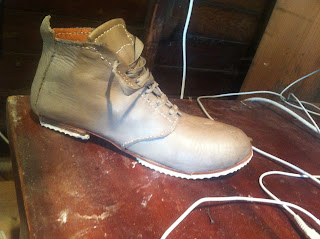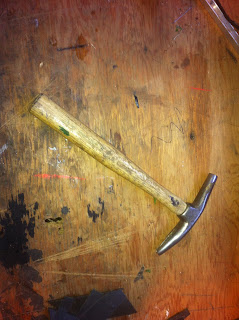The Japanese Skife. This is one of my favorite tools. It is highly versatile. While it is called a skife, I rarely use it as a skife. I use it to cut patterns, to create grooves in which I recess sole stitching. I use it to trim flush excess sole material. as with all cutting tools, it's important to keep it sharp. I devote a fair amount of time ot maintaining my tools. Anyone committed to working with leather using hand tools should invest in good set of wet stones and a strop. As well, take the time to learn the art of sharpening tools. For me, sharpening tools is meditative. It does not take long to do. And, it is yet another way for one to use their hands to work with tools. The more I work with my tools, the more I feel like they are an extension of me.
My Japanese Skife
Punches
The activity that consumes the most time and energy in the process of shoe making is stitching. Stitching is comprised of two stages, punching and threading. I come from a woodworking back ground. In many ways working with wood and leather are very similar. Some of the oldest structures in Japan are made of wood. The reason these structures have lasted so long has much to do with the way in which their builders built the structures. These structures are primarily joined together rather than being nailed together. The process of joining has many variations. But, simply put, when we join wood we make a space in on piece of wood that fits another piece of wood. Like a puzzle or a key, two pieces of wood join together in a way that does not cause undue stress on the wood. When we drive a nail into a piece of wood, we are forcing apart its fibers. That in itself is damage in the structure.
I take the same approach with leather. A stitch canot simply bedriven through a piece of leather. Doing so will stress the leather and cause tearing and eventual breakdown of the piece one is trying to build. So it is important to punch out every hole before picking up the needle and thread.
Hand stitching is an art. And, the result of hand stitching can be very beautiful. If you are interested in working with leather,I highly recommend devoting study to hand stitching. There is a book called TheArt of Hand Stitching, I will track down the author's information, and post it here.
My method is simple. First I use a stitch wheel to mark stitches (6 per inch.)
My stitch counter.
The stitch counter makes little dents in the leather spaced evenly. You can buy these wheels in different sizes to make different stitch spacing. The wheel allows you to simply drawout your stitch line. The result is even across curves and straight lines.
The next step is to punch holes. I use diamond punches (diamond referes to the shape of the whole.) One punch has four tines. These are spaced to match my stitch counter. I also have a single tine diamond punch which allows me to follow markings on curves.
Four diamonds
One diamond.
Punching Diamonds.
When punching the leather, you will need a solid surface that can be punched into beneath the leather. I use a large piece of fir structural lumber. There are special mats that can be used. It is important to use material that will not damage your tools. I recommend using fir.
Punch block.
Once I have punched out every marked stitch, I trace over the line with a marker tool. This is a steel tool that has a small rounded end. I dampen the leather slightly and apply pressure with the marker to make a slight recess for the stitches to sit in.
Marker
I use surgical needles that I buy from Oregon Leather for stitching. I use two needles. One needle at each end of my thread. I choose the length of thread by measuring the length of the line I will be stitching and multiplying by two and a half. If my stitch line will be 10 cm then my thread length will be (10 * 2.5 = 25cm.)
Quick lesson on stitching:
Bring the needle through the first hole from the nap side of the leather. Draw the thread through until the piece of leather is in the middle of the total length of the thread (the same length of thread should be on either side of the stitching piece.) Run the first needle through the second hole on the finished side. You should have both needles on the nap side now. Now use the other needle and bring it through the second hole on the nap side. You will now have one needle on each side of the leather. Carefully pull at both needles to make the stitch taught. Take the thread on the finished side and pull toward the bottom of the work. On the nap side pull the thread in the opposite direction (toward the top of the work.) Repeat these steps until you've completed your stitch line.
This post is really about my tools. I will do an expanded post about stitching soon.
Hammers!
My sledge hammer.
Hammers are essential. A sledge hammer is a great universal tool that gets used in my shop when I am glueing. After cement has set and pieces are stuck together one must hammer the pieces together to insure the cement bonds and air is forced out of the joint. I usemy sledged to drive most of my punching tools. I also use the sledge to hammer down stitches. I cover the stitches with a piece of scrap leather and tap down the stitches. Hammers don't work without having a solid work surface. So their counterparts are anvils.
Railroad steel anvil.
Like many leatherworkers, I have a piece of steel rail from a railroad that I use as my go to anvil for most tasks. I use this when tapping stitches, or hammering glued pieces. It is a great general purpose anvil.
My tack hammer.
I use my tack hammer to nail uppers to the last when I am lasting. One side is magnetic which helps hold nails.
No handle sledge.
I use this tool to set rivets and a handful of other tasks. It's a sledge hammer without a handle. It can function as a little anvil. It has a smooth face which helps when setting snaps and rivets.
Shoe Anvil Photo Here
The shoe anvil or jack stand is a great tool to use for attaching soles with glue. It has interchangeable pieces that correspond to shoe sizes. They are useful for attaching hardware in hard to get to pieces. It's an anvil that fits inside of the shoe. Very useful.
The 3-in-1
Again
My 3-in-1 does three jobs. One, it cuts through sole material with ease and precision. It also has a nice skiving option that I use to skive soles. I can also use it to press sole stitches. It really helps save time.
Skiver on the 3-in-1
Edger.
Edgers come in a few sizes. I recommend having one of each. It's also important to keep these sharpened. You can purchase a special strop that is shaped to match their blades. These tools are invaluable when they are sharp. They will frustrate and ruin your work if they are not sharpened. I use the edger to trim and bevel excess leather - usually above stitched lines. They are very useful for flush trimming rubber mid-soles.
more soon....
























































